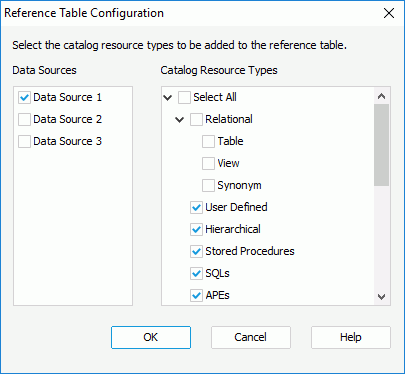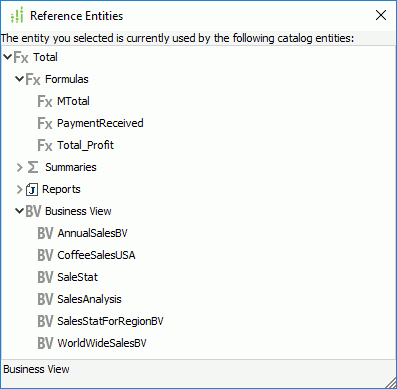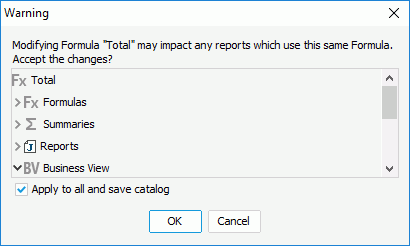Clarifying Resource Reference Relationships in a Catalog
With the development of reports and catalogs, the relationships between the catalog resources may become increasingly complicated. You might be wondering if and where a query or a formula is used by a resource in a catalog or report. You might hesitate to rename or edit a resource because you don't exactly know what other resources are currently using it and, if you change it what result it would cause. To help you manage catalog resources, Designer provides you with the tool - Reference Table. You can select the resource types you want to register in the reference table. Designer then monitors the reference information of the specified resource types in a catalog and stores this information in the reference table. This topic describes how you can configure the reference table and use it to help you clarify the reference relationships between resources in a catalog.
This topic contains the following sections:
- Configuring the Reference Table for a Catalog
- Viewing Reference Relationships in a Catalog
- Refreshing the Reference Table
- Exporting the Reference Table
Configuring the Reference Table for a Catalog
Before Designer can start to monitor and record the resource reference information in the reference table, you must first configure the reference table by choosing the resource types you want to add to the table. Designer then monitors the reference relationships between resources of these types and stores the relationship information in the database.
To configure the reference table for a catalog
- Open the catalog the resource reference relationships of which you want to clarify.
- On the Catalog Manager toolbar, select Configure Reference. Designer displays the Reference Table Configuration dialog box.

- In the Data Sources box, select the data sources in the catalog you want Designer to monitor.
- In the Catalog Resource Types box, select the resource types you want to add to the reference table. In order to improve product performance and provide you with more flexibility, Designer enables you to choose the resource types that you want to monitor by yourself. Designer only monitors the reference relationships between the resource types that you select. Designer does not monitor the resource types that you do not select, even if they may have reference relationships with the selected resource types. Therefore, if you are not sure whether the resource types you select hold all the possible reference relationships within themselves, you should select as many resource types as possible to avoid incomplete information. For example, in the Reference Table Configuration dialog box, selecting only the formula resource type means that for a formula, Designer only records the formulas referencing this formula in the reference table but does not display other resources such as queries, summaries, and reports that are also using this formula. If you rename a formula, Designer only prompts you the formulas using it. Designer ignores any other resources using the formula.
- Select OK to finish the configuration.
Viewing Reference Relationships for a Catalog
After you have configured the reference table, Designer monitors the reference relationships between the resources of the selected types. You can right-click a specific resource in the Catalog Manager and select Reference Entities from the shortcut menu to view its reference relationships with other resources. The Reference Entities window lists all entities of the specified resource types that are using the selected resource.

![]() In the Reference Entities window, you can right-click any of the query, business view, formula, parameter, or summary entity to edit it, and right-click any report entity to open the report.
In the Reference Entities window, you can right-click any of the query, business view, formula, parameter, or summary entity to edit it, and right-click any report entity to open the report.
In addition, when you rename a resource, Designer scans the reference relationships between it and other resources, and prompts you whether to update all the resources that use it, in order to help you reduce the risk of a missing resource causing a failure in other resources. If you clear "Apply to all and save catalog" in the Warning dialog box, the impacted resources cannot work correctly.

Refreshing the Reference Table
Designer stores the reference table information in a database, which provides reliable stability. However, in some circumstances, you may need to refresh the reference table to retrieve the correct reference relationship information. To do this, on the Catalog Manager toolbar, select Refresh Reference.
Exporting the Reference Table
You can export the reference table information to a text file.
- Select Export Reference on the Catalog Manager toolbar.
- In the Save Reference dialog box, specify the location where you want to save the file and select Save.
 Previous Topic
Previous Topic
 Back to top
Back to top